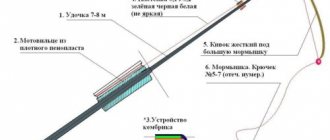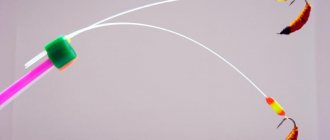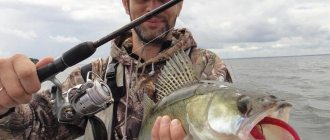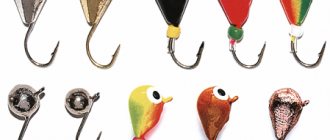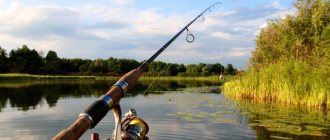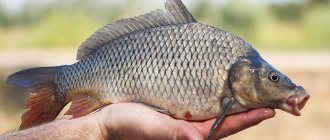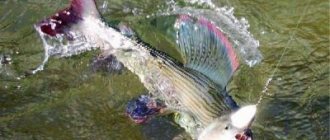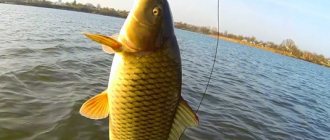Fishing with a summer jig with a side nod
A fishing rod with a side nod is one of the best ways to fish with a summer jig. This is quite a sporting way of fishing. Such tackle is allowed during the spring period, when both feeder and spinning rods are prohibited. In addition, with its help you can catch much more than with a regular float rod from the shore. A fishing rod with a side nod is catchy and so interesting that many people completely switch to it.
Side nods for fish of different sizes
Bites on the side nod may look like a sharp bend of the nod, its rise up or stop. It happens that there are empty bites, this is not always a trifle. It may be necessary to change the jig or game, or perhaps it is necessary for the fishing area to temporarily “rest.” It will be useful to take a short break in fishing and try to find another working area. Then you can go back or continue searching.
Selecting an “edible” jig is quite a difficult job. You can experiment on your own and try to choose the shape, color, size of the jig and its equipment, or rely on someone else’s experience. When fishing with a side nod for perch, roach, bream, and crucian carp, unpainted, shiny, black jigs with hooks equipped with small beads work well. You will have to suffer when choosing a size. There is no ideal size. The fish can perfectly grab a large jig (more than 10 mm), but not notice a small one (up to 7 mm). Bead color: blue, cherry, ruby, yellow, white. It happens that adding a piece of rubber or foam rubber can have a positive effect.
Fishing with a side nod with live baits - maggots, bloodworms, worms, etc., as well as with complementary foods, is uninteresting: the sportiness and dynamics of fishing are lost. It’s more interesting to choose the right jig, its action - and go for the catch
Rigging a fishing rod with a side nod
Fishing with a summer jig with a side nod differs in two types of gear:
- Blind tackle
- Tackle with a reel.
Blind tackle is used for shore fishing and wading due to its lighter weight. Equipment with a reel is more often used for fishing from a boat and much less often from the shore. Due to the low prevalence of such fishing from a boat, only tackle for fishing from the shore with a blind rig is considered below.
Rod
For fishing, only telescopic rods are used - they are light, transportable and easy to handle.
For fishing from the shore, blind tackle is more suitable. You will have to hold the rod in your hands all day and walk with it. It should be long enough for fishing from the shore - from six to ten meters. Most anglers are on a budget and can't afford ultra-light high modulus carbon rods, plug rods and the like. The price of a good long graphite or plug rod is from 4,000 rubles and above, even price tags up to 100,000 can be found.
Now you can buy a relatively good telescopic rod without rings made of composite, seven meters long. The asking price is 1100-1500 rubles. This length is the golden mean between a heavy, long rod and a light, but short one. The composite has a good tip, which allows you to play well with the jig and confidently drive the fish. Of course, it is heavier than carbon, but not by much.
A small life hack: before each fishing trip, the rod is disassembled, all butts of the knees are lubricated with paraffin. This way they will not wear out, jam and will last longer.
Equipment
A blind rig means that you make the rod as light as possible and it will be easier for you to hold it in your hand. After all, each ring becomes heavier the closer it is to the tip of the fishing rod. Blind tackle consists of a reel, which is attached to the upper knee of the fishing rod or to the second, fishing line, which is wound on the reel and then wrapped around the upper knee several times, and a connector, which is attached to the tip of the rod and the nod is attached to it. It is better to make the connector with a free passage for the fishing line, rather than a blind one, so that you can quickly change the length of the fishing line by unwinding a little from the reel.
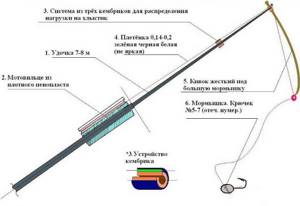
A reel in its simplest form is a purchased plastic reel, which is fastened to the fishing rod with an elastic band. The lighter it is, the better. Usually the reel is made of polystyrene foam. Its size is up to 10 cm in length, because we don’t need a lot of fishing line.
The most progressive option is when the reel has a hole and is put on the upper knee all the way to the base. There are fastening options with metal parts, but they are all much worse, as they are much heavier.
The reel is not used for a simple reason - you will often have to wade fishing, and in this case the butt of the rod will fall into the water. This is not very good for the coil, and it will quickly fail. In addition, a rod with rings will feel much heavier in your hand, as already mentioned.
fishing line
The line is taken from 0.08 to 0.2. Usually, even with blind tackle, there are no problems with catching prey - on a 0.15 fishing line you can pull out a trophy weighing 2 kilograms, with a little suffering. Typically the weight of the caught fish ranges from 100 grams to a kilogram. And here it would be wise to set the fishing line to 0.16.
It is better to take a stretchable fishing line so that it dampens the jerks of the fish. This will have little effect on the game of the jig - the vacation is very short. When fishing for large fish, the fishing rod is immediately folded from the thickest knees until an acceptable length for fishing is equal to the length of the fishing line.
After installing the reel, the line is immediately wrapped several times around the upper bend, and then passed through the connector. This is very important - the turns of the fishing line act like rings, evenly distributing the load along the weak tip.
Important factors when fishing with a side nod
Wind
The not very strong wind is our ally. When there is wind, the water is evenly mixed, and this has a good effect on the bite. If the water is somewhat choppy, it will be easier to approach the fish by boat. If you are fishing by wading, you should enter the water carefully. If the water in the reservoir is clear, the intended prey is quite cautious. You need to go in 2-3 steps at a time, and try not to muddy the waters. It is better if the wave is breaking, as in this case the fish comes closer to the shore.
If the wind is sideways, fishing will be inconvenient - it can bend the fishing line and rod. If the wind is strong, then it is impossible to fish at all; it can simply break the rod. And with little or no wind, the fish becomes passive and moves at a distance from the shore, so it is difficult to reach it in the calm.
Bottom relief
For fishing with a side nod and wade, long, lightly overgrown streams are quite attractive. Fish come to these places to feed. You can go far enough along them to get close to the fish, and the vegetation allows you to camouflage the angler.
Fishing with a side nod will be quite successful if you manage to go behind long stems of reeds or reeds; various unevenness of the bottom of the relief and not very old snags are also attractive.
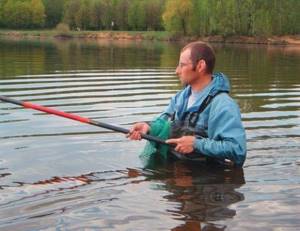
Active search for fish
The angler's attention should also be drawn to low-leaning trees, or even trees that have fallen into the water. Especially when fishing with a jig on the river.
Time of day and season
Perhaps spring is the most suitable time for fishing with a side nod. At this time, you can successfully get to the pre-spawning feast. The fish gather in large schools, and they become less timid, biting with excitement and often throughout the day. During the spawning period, the fish comes to the shallows up to one meter, and at the same time it is quite often and well caught using a side nod. Mostly males are caught. Whether to fish during the spawning period or not is already a matter of fisherman’s ethics. Everyone decides this for themselves.
After spawning, the bite subsides. The fish is exhausted, sick and is unlikely to swim for the jig. Such attachments as a worm, bloodworm, maggot, etc. will not be superfluous.
The bite will resume in a couple of days, or even weeks. There are many factors that influence the fish’s bite when fishing with a side nod. Mass flights of insects are an excellent moment for fishing with a side nod (this cannot be said about float fishing). Fish can bite on all layers of water, and sometimes even from the very surface of the water.
Fish can grab the jig all day long. But mostly from one to several approaches. The morning exit, as a rule, is at dawn and after one or two hours (this is a typical exit in fairly clear water). With moderate winds in the surf, there can be some good daytime outings.
The bite directly depends on the transparency, temperature and illumination of the water. In cloudy weather, the bite is best in cold, clear water, and, conversely, in sunny weather, in cloudy water.
During all the summer months, fishing on the side nod is quite successful. In shallow, stagnant bodies of water, the bite can be passive. When it gets too hot, algae and water bloom wildly in them, and this negatively affects the bite.
At the beginning of summer, in reservoirs, quarries and lakes, crucian carp, bream, roach and carp often approach the shore. In persistent warm weather, sometimes fish can move out into fairly shallow areas. When the weather worsens, the fish go deeper.
Fishing with a side nod from a boat
When fishing from a boat on a side nod, the fisherman does not depend on approaches to the shore of fish within reach (as when fishing from the very shore and wading). From a boat it is possible to “process” the entire body of water – from coastal shallows to deep holes. A fish is much less afraid of a boat than a fisherman standing in the water.
You need to actively look for fish. You can start by searching in the shallows, and then move towards the depths (or vice versa), after which return to the places where there were the most bites.
In such places, you can try to attract fish with the help of complementary foods. This can also be done by wading. Most often, 3-4 balls the size of a fist are thrown. But regularity is important, not quantity.
The fertilizing should not be too rich. For example, standard unicord and some kind of ballast (sand, earth, clay). A good option is feeding, to which bloodworm and maggot larvae are added. When fishing with a side nod in clear water, you should try to muddy the water in the fishing zone - throw in a few lumps of sand, earth, clay.
If you are fishing from a boat, you should anchor well. The boat should not spin around its axis, wobble or wobble at the bow. When fishing or in the wind, a long fishing rod is capable of moving a boat from anchors or cargo like a lever.
In very strong winds and on high waves, fishing with a side nod will simply be impossible.
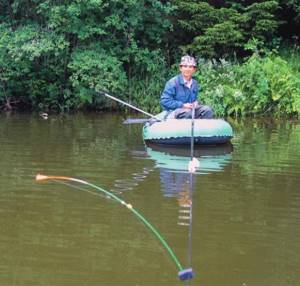
Fishing with a side nod from a boat
If you are planning to fish from a boat, be prepared to change your anchorage frequently. Reliably standing up and removing two anchors is quite a difficult task.
When looking for fish, it doesn’t hurt to watch the surface of the water. Regular small bubbles or frequent bursts can reveal the desired school (crucian carp, roach, bream, etc.).
Fishing technique and tactics
Before fishing, it is important to think through a plan of action. You should start from the type of fish you are going to the pond to find. Here are several typical cases.
Features of crucian carp fishing
When the bite on the feeder or float in crucian carp reservoirs subsides, the only reliable way to catch fish is a summer jig. Sensitive tackle allows you to instantly respond to the slightest bite, and the movement of the jig in the water column activates even dormant crucian carp. There is an opinion that in cold weather fish respond better to vertical fishing than to horizontal movement of the bait.
The fisherman can choose 3 tactical fishing patterns.
- The boat helps to find crucian carp on lakes with muddy bottoms, where it is not possible to get close to the wades. The watercraft also comes to the rescue in the case of a heavily overgrown coastal zone. The length of the fishing rod is chosen within 5-6 m.
- You can fish small ponds from the shore without any problems. Here the depth is approximately the same, and the coastline is clean. But in this case, a long rod of 7-8 m is required.
- It is most convenient to hunt for crucian carp in a wading suit. This equipment allows you to get close to a promising place, you can use fishing rods of 6-7 m.
It is important! Whatever option is adopted, you must behave quietly and carefully. Large fish sense the presence of a person and will keep their distance from him.
Patience becomes the fisherman's main weapon. Once you enter the water, you must remain motionless for 5-10 minutes. At this time, experienced crucian fishermen advise lowering the fishing rod onto the stand and smoking a cigarette. After 5 minutes, the first careful movements are made. For small things, fast vibrations with high amplitude are suitable. The fishing technique for respectable crucian carp is radically different. Most often, a slow rise of the bait from the bottom surface to a height of 5 cm works. At the top of the rise, a stop is made for 2-3 seconds, after which the upward movement continues. Having lowered the jig to the bottom, it is useful to move it, raising a cloud of turbidity. If the bites are cautious and unnoticeable, it is worth replacing lead jigs with tungsten ones.
Roach fishing
In autumn, schools of roach move to deep waters. Based on this, fishing from a boat or wading looks preferable. Roach’s favorite jigs are pellet, droplet, uralka, oatmeal, and ant. The optimal colors for fall are black and gray. The fish are not too afraid of the angler, so you can start fishing immediately after stopping in an interesting place. There are several effective techniques for fishing with a jig in the fall.
- The simplest technique is to slowly evenly lift the equipment from the bottom to a height of 3-5 cm. The stop lasts 1-3 seconds, after which the jig drops to the bottom. After touching the ground, you should move the bait and lift it slightly.
- It is not difficult to do this kind of wiring. First, a slow rise of a few centimeters is performed. Having reached the required height, the bait should be moved alternately in one direction and the other.
- Horizontal movements are performed at the bottom. When the jig reaches the extreme point in one of the directions, a long pause is made, up to 10 s.
When fishing for roach, you can use bait. It is chosen to be dark in color with a low feed content. The mixture must be sifted; it is more convenient to lower portions of the prepared bait using a small cup.
How to catch rotan?
Rotan is considered one of the most picky fish. This small predator has a large mouth, which, combined with greed, allows the fisherman not to stand on ceremony. Even a fishing line 0.20 mm thick does not frighten this voracious fish. The easiest way to seduce rotan is with animal bait, such as a worm, a bunch of bloodworms or a whitebait. You can fish from the shore, boat or wade.
As for the wiring, you will have to experiment. Active fish bite on fast movements with a large amplitude. A passive fish is unbalanced by small tremors in a certain layer of water. A slow rise of the jig from the bottom is successful.
Recommendation! Even in a small body of water, rotan occupies certain areas. Therefore, you need to immediately find the fish, and then engage in targeted fishing.
Chasing the Perch
Perch gives the angler wide scope for imagination and experimentation. This fish is found in small ponds, oxbow lakes, lakes and reservoirs. Depending on the size of the reservoir and the terrain, one of the appropriate tactics is selected. In most cases, you can fish well from the shore or by wading. When fishing, you can use different jigs, spinners, tandems with silicone, etc. There are several promising fishing patterns.
- When using attachment jigs, a smooth technique is used with a slow rise and fall. It is useful to fidget with the bait at the bottom.
- In quiet river bays, striped robbers hunt at mid-water, picking up living organisms falling into the water along with leaves. The wiring looks like dipping a jig to the half-water level. Burdock moth larvae, ant eggs, and bloodworms are attached to the hook.
- In areas with a clean bottom, imitation of the nymph's behavior brings success. To do this, the jig with bait sinks to the bottom and slowly moves along the ground, first in one direction, then in the other.
The side nod provides the angler with a real opportunity to have a pleasant rest on the pond in the fall. You just need to properly equip the fishing rod and choose the appropriate wiring.
